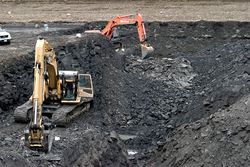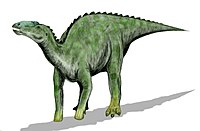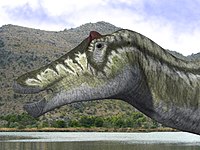

| Bearpaw Formation | |
|---|---|
| Stratigraphic range: Campanian-Maastrichtian, 75–72 Ma
↓ | |

Contact (red arrow) between the underlying marine shales of the Bearpaw Formation and the coastal Horseshoe Canyon Formation.
| |
| Type | Geological formation |
| Unit of | Montana Group |
| Underlies | Horseshoe Canyon Formation, St. Mary River Formation, Eastend Formation, and others |
| Overlies | Dinosaur Park Formation, Judith River Formation |
| Thickness | Up to 350 meters (1,150 ft)[1] |
| Lithology | |
| Primary | Shale, claystone |
| Other | Siltstone, sandstone, concretionary beds |
| Location | |
| Coordinates | 48°15′0″N 109°30′0″W / 48.25000°N 109.50000°W / 48.25000; -109.50000 (Bearpaw Formation) |
| Region | Alberta, Saskatchewan, Montana |
| Country | Canada, United States |
| Extent | Northern Montanatocentral Alberta and southern Saskatchewan |
| Type section | |
| Named for | Bear Paw Mountains, Montana |
| Named by | Hatcher and Stanton, 1903[2] |
The Bearpaw Formation, also called the Bearpaw Shale, is a geologic formationofLate Cretaceous (Campanian) age. It outcrops in the U.S. state of Montana, as well as the Canadian provinces of Alberta and Saskatchewan, and was named for the Bear Paw Mountains in Montana.[2] It includes a wide range of marine fossils, as well as the remains of a few dinosaurs. It is known for its fossil ammonites, some of which are mined in Alberta to produce the organic gemstone ammolite.[3]

The formation was deposited in the Bearpaw Sea, which was part of the Western Interior Seaway that advanced and then retreated across the region during Campanian time.[4] It is composed primarily of dark grey shales, claystones, silty claystones and siltstones, with subordinate silty sandstones. It also includes bedded and nodular concretions (both calcareous and ironstone concretions) and thin beds of bentonite. As the seaway retreated toward the southwest, the marine sediments of the Bearpaw became covered by the deltaic and coastal plain sediments of the overlying formations.[1][5][6]
The Bearpaw Formation conformably overlies the Dinosaur Park Formation of the Belly River Group in central Alberta, and the Judith River Formation in the plains to the east and Montana. It is overlain by the Horseshoe Canyon Formation in central Alberta; by the Blood Reserve Formation and the St. Mary River Formation in southern Alberta; by the Eastend Formation in southern Saskatchewan; and by the Fox Hills Formation in Montana. To the east, it merges into the Pierre Shale.[1]
Color key
|
Notes Uncertain or tentative taxa are in small text; |

The Bearpaw Formation is famous for its well-preserved ammonite fossils. These include Placenticeras meeki, Placenticeras intercalare, Hoploscaphites, and Sphenodiscus, the baculite Baculites compressus and the bivalve Inoceramus, some of which are mined south-central Alberta to produce the organic gemstone ammolite.[3]
Other fossils found in this formation include many types of shellfish, bony fish, sharks, rays, birds, and marine reptiles like mosasaurs such as Prognathodon overtoni and Plioplatecarpus peckensis, plesiosaurs such as Dolichorhynchops herschelensis, Albertonectes and Nakonanectes, and sea turtles. Dinosaur remains have occasionally been discovered, presumably from carcasses that washed out to sea.[7][8]
| Dinosaurs from the Bearpaw Formation | ||||||
|---|---|---|---|---|---|---|
| Genus | Species | Location | Member | Material | Notes | Images |
| Brachylophosaurus[7] | Indeterminate[7] |  | ||||
| Daspletosaurus |  | |||||
| Edmontonia[7] | Indeterminate[7] |  | ||||
| cf. Kritosaurus | "Nearly complete skull and postcranium."[9] | A hadrosaurid |  | |||
| Prosaurolophus[7][10] | P. maximus[10] | Three juvenile specimens[10] | ASaurolophinae hadrosaurid, also known from the Dinosaur Park and Two Medicine Formations |  | ||
| Stegoceras[7] | Indeterminate[7] |  | ||||
| Plesiosaurs from the Bearpaw Formation | ||||||
|---|---|---|---|---|---|---|
| Genus | Species | Location | Member | Material | Notes | Images |
| Albertonectes[11] | A. vanderveldei | Alberta | A complete, well-preserved postcranial specimen, missing only the skull. | Anelasmosaurid plesiosaur. Albertonectes has the longest neck of any known plesiosaur. |  | |
| Nakonanectes[12] | N. bradti | Montana | A nearly complete skeleton including the skull. | A small elasmosaurid plesiosaur with an unusually short neck. | ||
| Terminonatator[13] | T. ponteixensis | Saskatchewan | A partially articulated incomplete skeleton, including a skull. | An elasmosaurid plesiosaur. | ||
| Dolichorhynchops[14] | D. herschelensis | Saskatchewan | An incomplete skeleton | One of the latest known polycotylids. | ||
| Mosasaurs from the Bearpaw Formation | ||||||
|---|---|---|---|---|---|---|
| Genus | Species | Location | Member | Material | Notes | Images |
| Mosasaurus[15] | M. missouriensis | Alberta and Montana | Several specimens, including a near complete skeleton with stomach contents | A large mosasaurine mosasaur. |  | |
| M. conodon | Saskatchewan | A large mosasaurine mosasaur. |  | |||
| Prognathodon[16] | P. overtoni | Alberta | Several exceptionally preserved specimens | A large mosasaurine mosasaur. |  | |
| Plioplatecarpus[17] | P. primaevus | Saskatchewan | A widespread genus of plioplatecarpine mosasaur. |  | ||
| P. peckensis | Montana | |||||
| Tylosaurus[18] | T. saskatchewanensis | Saskatchewan | A single semi-complete skeleton | A large tylosaurine mosasaur. |  | |
| Turtles from the Bearpaw Formation | ||||||
|---|---|---|---|---|---|---|
| Genus | Species | Location | Member | Material | Notes | Images |
| Nichollsemys | N. baieri | Alberta | Known from skulls | A basal chelonioid sea turtle. |  | |
|
| |
|---|---|
| Hydrocarbon history |
|
| Depositional regions |
|
| Northeastern plains |
|
| Central Alberta |
|
| Saskatchewan |
|